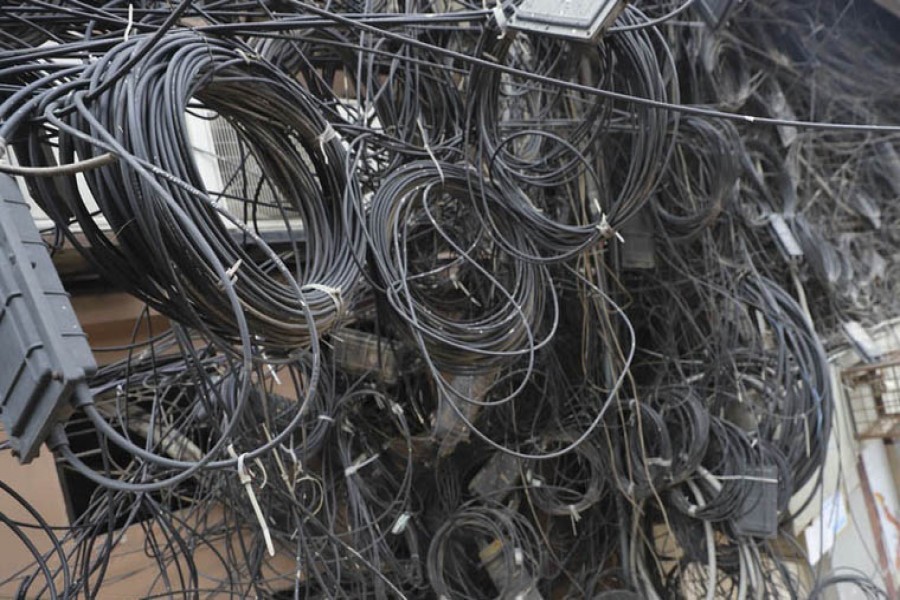
Published :
Updated :

Overhead cables are making a greater mess with time for reasons understandable. With sprawling housing complexes popping up, multi-storied residential and commercial buildings dotting vacant city spaces and replacing smaller accommodations, the networks of electric cables, dish, telephone and internet cables are expanding unrelentingly. Some of those cables and wires are seen dangling precariously on footpaths.
Not only are the jumbles of cables and wires an eyesore but also a threat to life of pedestrians. When storms lash the city, uprooted or broken trees and branches of trees come down on live electric and other cables raising the level of danger many times more. Along with pedestrians, commuters inside vehicles--- either parked or moving--- run the risk of coming in contact with those cables and wires and getting electrocuted.
A country well set on course of digitisation should find the overhead exposed cables and wires ill-matched to its advanced technological transformation. The authorities are also aware of the disadvantages and dangers of the overhead dangling cables. So, in 2009, they came up with the idea of removing the mess and building a network of underground cables and wires.
However, the move lacked seriousness right from the beginning. One of the reasons is, of course, a lack of required fund and the other one is no less significant. It is the perennial absence of coordination between and among various utility services when it comes to digging roads for repair or laying of various utility's pipes and cables afresh. With private entities providing cable TV and internet connections, their networks of cables and wires also have to be placed underground alongside other cables and wires.
The Dhaka Power Distribution Company (DPDC) Ltd and Dhaka Electric Supply Company (DESCO) and a few other organisations reportedly have completed a total of 2,692 kilometre underground cable connections. So far as the main city's underground cable networking is concerned, the progress is nothing remarkable. According to a report carried in a Bangla contemporary, the DPDC has completed work from Jahingir Gate of Dhaka cantonment to Farmgate. The project taken up in 2016 actually started work in 2021 and the 19-kilometre Gahangir Gate-Bangabhaban and the 10-kilometre Gabtoli-Azimpur roads' underground cable setting started only in January this year. But the authorities are optimistic that by the deadline of 2024, the project can be completed.
How this can be done is, however, not understandable. It is a challenging task. There is a need for setting up transformers and ring main units (RMU) on the side of narrow and crowded roads. The greatest challenge is to integrate all the utility services' cables, wires and pipes so that one's renovation or repair does not interfere with that of another and thus cause slashing wires and cables.
Also concerning is the fact that in the greater part of the city the various organisations' feasibility study on underground networking and preparation of maps are yet to be completed. The DESCO has so far taken up a pilot project in Gulshan-Baridhara area. Thus here is a clear evidence that things are hardly progressing as it should have. Also there is a question of allocation of fund on an analysis of the feasibility report.
About the removal of the overhead cables and wires there are perhaps no two opinions. The idea was mooted in 2009 and it has staggered time and again only to the stage of implementation in 2021. A year and a quarter of another year have already passed. The year 2024 is not far away. Even this delay can be accepted if there is a comprehensive plan to bring electric, telephone, dish and broadband internet cables and wires under an integrated underground networking system to avoid damage to or snapping of one system's wires for another's work. The internet cables often become victims of such disruptions causing great inconvenience to internet subscribers.


 For all latest news, follow The Financial Express Google News channel.
For all latest news, follow The Financial Express Google News channel.